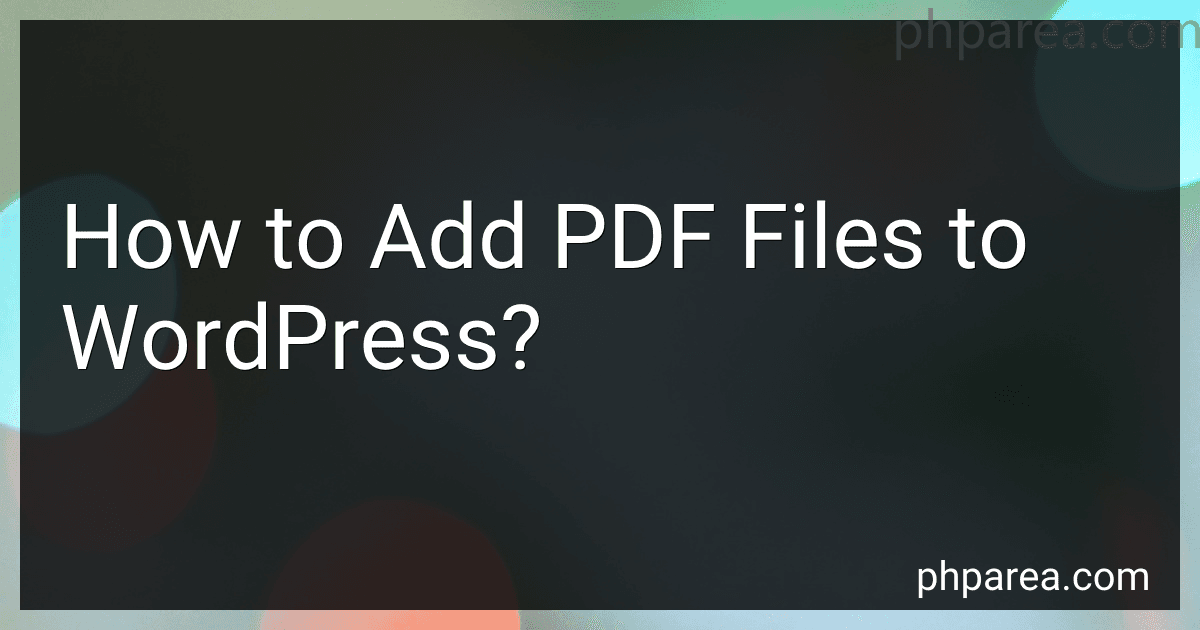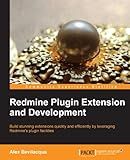Best PDF Plugins for WordPress to Buy in December 2025
To add PDF files to WordPress, you can follow the steps mentioned below:
- Login to your WordPress admin dashboard.
- Navigate to the page or post where you want to add the PDF file.
- Click on the "Add Media" button above the editor.
- A new media window will open. Click on the "Upload Files" tab.
- Drag and drop the PDF file from your computer to that window, or click on the "Select Files" button to browse and select the file manually.
- Once the PDF file is uploaded, select it by clicking on it.
- On the right-hand side, you will find the attachment details options. Enter a title, caption, and description if required.
- Under the "Attachment Display Settings" section, you can choose how you want the PDF file to be displayed. For example, you can select "Media File" to display a direct link to the PDF file.
- Once you have entered the necessary details and set the display settings, click on the "Insert into post" button.
- The PDF file will be added to your page or post.
- You can now save or publish your page or post to make the PDF file visible on your website.
Note: WordPress will automatically generate a thumbnail for the PDF file, which you can click on to view or download the file.
How to troubleshoot issues with PDF uploads in WordPress?
If you are experiencing issues with PDF uploads in WordPress, you can follow these troubleshooting steps:
- Check File Size: Ensure that the file size of the PDF you are trying to upload is within the upload limit set by WordPress. By default, the maximum file size is often 2MB, but it can be increased by modifying the server settings or using a plugin.
- File Permissions: Verify that the permissions of the PDF file are correctly set. They should generally be set to 644 or 755, allowing read access for all users.
- File Format: Ensure that the PDF file is not corrupt or damaged. Try opening it with a PDF viewer to verify its integrity. If it is corrupted, you may need to obtain a fresh copy.
- Plugin or Theme Conflict: Temporarily deactivate any plugins or switch to a default WordPress theme to see if the issue persists. Sometimes, conflicts between plugins or themes can cause problems with PDF uploads.
- Clear Cache: If you are using a caching plugin, clear the cache and try uploading the PDF again. Caching can sometimes cause issues with file uploads.
- PHP Version and Memory Limit: Verify that your PHP version is up to date and that your server has enough memory allocated for the upload. Check with your hosting provider or adjust the PHP settings to increase the memory limit. Insufficient memory can cause issues with large or complex PDF files.
- Use a Different Browser: Sometimes, the issue may be browser-specific. Try uploading the PDF using a different browser (e.g., Chrome, Firefox, Safari) to determine if the problem lies with the browser you are currently using.
- Update WordPress: Ensure that you are using the latest version of WordPress. Outdated versions may have bugs or compatibility issues that could affect PDF uploads.
- File Upload Path: Check the file upload path in the WordPress media settings. Ensure that it points to the correct directory where PDF uploads are allowed. If the path is incorrect, the PDF upload may fail.
- Contact Hosting Provider: If none of the above steps resolve the issue, it could be a server configuration problem. Contact your hosting provider and provide them with the details of the problem. They may be able to identify any server-specific issues causing problems with PDF uploads.
By following these troubleshooting steps, you should be able to diagnose and resolve common issues with PDF uploads in WordPress.
What is the recommended plugin for handling PDF files in WordPress?
One of the most recommended plugins for handling PDF files in WordPress is "PDF Embedder." It allows you to easily upload and embed PDF files into your WordPress posts or pages without the need for any additional software or coding. The plugin also provides a pleasant and user-friendly interface for visitors to view and interact with the embedded PDF files.
What are the common security risks associated with PDF files in WordPress?
Some common security risks associated with PDF files in WordPress include:
- Malicious Code Injection: PDF files can contain embedded scripts or code that exploits vulnerabilities in PDF readers or plugins, potentially granting unauthorized access to the server or compromising user data.
- file Disclosure: If PDF files are stored in publicly accessible directories, attackers can directly access them and obtain sensitive information stored within those files.
- Content Spoofing or Phishing: Attackers may create deceptive PDF files that appear legitimate but actually include malicious links, forms, or content designed to trick users into revealing sensitive information or installing malware.
- Exploiting Vulnerabilities in PDF Readers or Plugins: PDF readers and their associated plugins may have vulnerabilities that can be exploited by attackers to gain unauthorized access or perform malicious activities on the server or user devices.
- Cross-Site Scripting (XSS) attacks: PDF files can be used to inject malicious scripts into the WordPress site, which, if executed, can lead to website defacement, theft of sensitive information, or unauthorized actions on the site.
- Denial-of-Service (DoS) Attacks: Attackers can craft PDF files that cause resource-intensive tasks or exploit vulnerabilities, leading to system crashes or slowing down the website's performance.
- File Upload Vulnerabilities: If PDF file uploads are not properly validated or secured, attackers can upload malicious PDF files that can infect other files, execute arbitrary code, or gain unauthorized access to the server.
To mitigate these risks, it's important to keep the WordPress core, themes, and plugins up-to-date, use trusted and reputable PDF reader plugins, restrict public access to PDF files (e.g., using .htaccess rules), employ web application firewalls, regularly scan for malware, and apply strict file upload validation and security measures.
How to add PDF files to a menu in WordPress?
To add PDF files to a menu in WordPress, you can follow these steps:
- Log in to your WordPress admin dashboard.
- Go to "Appearance" and then click on "Menus".
- Create a new menu or edit an existing menu.
- Find the "Custom Links" option and click on it.
- In the "URL" field, enter the direct URL of the PDF file. Make sure the URL ends with ".pdf".
- In the "Link Text" field, enter the anchor text or name of the PDF file that you want to display in the menu.
- Click on the "Add to Menu" button to add the custom link to your menu.
- Rearrange the menu items if necessary by dragging and dropping them to the desired position.
- Save the menu.
- Refresh your website, and you should see the PDF file added as a link in your WordPress menu.
Note: Some themes may have different menu settings or support for PDF files. If the above steps don't work, you can also try using a PDF plugin specifically designed to handle PDF files in WordPress.
How to add a table of contents to a PDF in WordPress?
To add a table of contents to a PDF in WordPress, you can follow these steps:
- Upload the PDF to your WordPress site. You can do this by navigating to your WordPress dashboard, selecting "Media" and then "Add New". Upload the PDF file from your computer and wait for it to finish uploading.
- Install and activate a PDF viewer plugin that supports table of contents generation. One popular plugin is "PDF Embedder" which can be found in the WordPress plugin repository.
- Once the plugin is activated, go to the post or page where you want to display the PDF and click on the "Add Media" button.
- In the media library popup, switch to the "Insert from URL" tab and paste the URL of the PDF file you uploaded in step 1. Click on the "Insert into post" button to add the PDF to your post or page.
- In the editing area, you will see a shortcode representing the PDF file. You can customize the display options of the PDF viewer by modifying the shortcode parameters. To enable the table of contents, you can add the "toolbar=1" parameter to the shortcode. For example: [pdf-embedder url="yourpdfurl.com" toolbar="1"]
- Update or publish the post/page to see the PDF with the table of contents. You should see a table of contents toolbar displayed above the embedded PDF where users can navigate through different sections of the document.
Note: The specific steps may vary depending on the PDF viewer plugin you choose to use, but generally, these are the basic steps to add a table of contents to a PDF in WordPress.
How to upload a PDF file to the Media Library in WordPress?
To upload a PDF file to the Media Library in WordPress, follow these steps:
- Login to your WordPress admin dashboard.
- From the left-hand menu, click on "Media" and then select "Library".
- On the Media Library page, click on the "Add New" button.
- You will now see the file upload box. Click on the "Select Files" button to choose the PDF file from your computer, or simply drag and drop the file into the box.
- Once selected, the file will start uploading. You can see the progress in the upload bar.
- Once the upload is complete, you will see the PDF file listed in the Media Library.
- Optionally, you can add a title, caption, alt text, and description to the PDF file by clicking on the "Edit" button below the file.
- After making any desired changes, click the "Update" button to save the information.
Now, you can use the uploaded PDF file in your WordPress posts or pages by adding a link to it or embedding it using specific plugins or shortcodes.
How to customize the appearance of PDF links in WordPress?
To customize the appearance of PDF links in WordPress, you can follow these steps:
- Open your WordPress dashboard and go to the Appearance > Customize tab.
- Navigate to the Additional CSS section.
- Add the following CSS code to customize the appearance of PDF links: /* Customize the PDF link color */ a[href$=".pdf"] { color: #ff0000; /* Replace #ff0000 with your desired color */ } /* Customize the PDF link hover color */ a[href$=".pdf"]:hover { color: #00ff00; /* Replace #00ff00 with your desired hover color */ } /* Customize the PDF link text decoration */ a[href$=".pdf"] { text-decoration: none; /* Remove if you want the default underline */ } /* Customize the PDF link hover text decoration */ a[href$=".pdf"]:hover { text-decoration: underline; /* Replace underline with none to remove hover effect */ }
- Replace the color values and text decoration styles in the code with your desired customization.
- Click on the "Publish" button to save your changes.
This CSS code will target PDF links based on the file extension (.pdf) and allow you to customize their appearance, including color, hover color, text decoration, etc.
How to insert a PDF link in a WordPress post or page?
To insert a PDF link in a WordPress post or page, follow these steps:
- Log in to your WordPress dashboard.
- Create a new post or edit an existing one where you want to insert the PDF link.
- Click on the "Add Media" button above the content editor.
- In the media library, either select the PDF file if it is already uploaded, or click on the "Upload Files" tab to upload the PDF file from your computer.
- Once the PDF file is uploaded or selected, click on the file to open the attachment details.
- In the attachment details, you can edit the title, caption, and description if desired. Make sure the "Link To" option is set to "Media File".
- Copy the File URL under the "URL" field.
- Close the attachment details by clicking the "X" button in the top right corner.
- In the content editor, type the desired text or select an existing text where you want to insert the PDF link.
- Highlight the text and click on the "Insert/edit link" button in the toolbar (looks like a chain link).
- In the insert link popup, paste the copied File URL in the "URL" field.
- Click the "Apply" or "Insert" button to insert the link.
- Preview or publish your post to see the PDF link, and clicking on it will allow visitors to download or view the PDF file.
Note: The steps may vary slightly depending on the version of WordPress you are using and any installed plugins that may influence the media library or link insertion process.
What is WordPress and how does it work?
WordPress is a popular content management system (CMS) that allows users to create, design, and manage websites easily without the need for technical knowledge or coding skills.
Here's how WordPress works:
- Installation: WordPress needs to be installed on a web server. Users can choose to install it on their own server or use a hosting provider that offers WordPress installation.
- Setup: After installation, users need to configure the basic settings such as site title, tagline, and permalink structure. Users can also choose a theme, which controls the appearance and layout of the website.
- Content Creation: WordPress provides an intuitive interface for creating and managing content. Users can create pages, blog posts, and other custom post types, and easily add text, images, videos, and other media to their content.
- Theme Customization: WordPress offers thousands of themes that users can choose from or customize to match their desired look and feel. Users can customize the layout, colors, fonts, and other design elements using the native theme customizer or by editing the theme's code.
- Plugins: Users can extend the functionality of their WordPress website by installing plugins. Plugins are software components that add specific features and functionality, such as contact forms, SEO optimization, e-commerce capabilities, social media integration, and more.
- Publishing: Once the content is created and customized, users can publish it on their website. WordPress automatically manages the organization and display of the content, creating a user-friendly navigation structure and presenting the content according to the chosen theme.
- Updates and Maintenance: WordPress regularly releases updates to enhance security, fix bugs, and introduce new features. Users are notified of these updates and can easily install them to keep their website running smoothly.
Overall, WordPress simplifies the process of building and maintaining a website, offering a user-friendly interface and a wide range of customization options.




